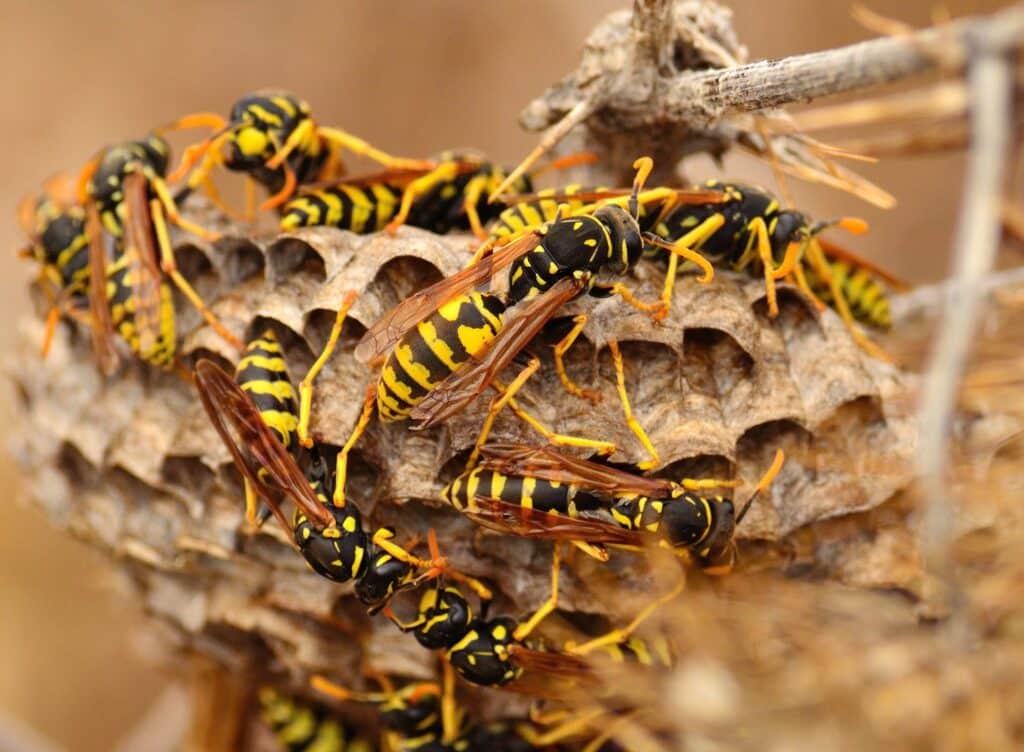There are four common types of social wasps found in North America, the paper wasp, yellowjackets and bald-faced hornets. Each of these species lives in colonies similar to ants and termites, where there is a queen, workers and males.
Each social wasp colony only lasts about one year, and a new colony is built from scratch each spring. Colonies are not made in the same place each year; a new location is sought year after year. During the first freeze, all wasps in the colony will die except the queen, which remains to start the colony again after the weather warms back up.
Types of Social Wasps
Social wasps have a thorax and abdomen that are brightly marked with a yellow, red or brown background. Their bodies are short with a narrow attachment between the thorax and the abdomen, which is shaped like a spindle and tipped with a long stinger. They also have short antennae, large compound eyes and four wings that are clear or smoky brown in color.
Paper Wasps are marked with yellow, brown or red patterns on black and measure 5/8 to 3/4 of an inch in length. They build umbrella-shaped nests that can often be found hanging on porches, inside light fixtures and on the overhangs of buildings. A paper wasp colony generally starts with no more than 25 wasps, but as the season progresses, that number can increase to more than 100.
Yellowjackets are similar in size and shape to honey bees, but rather than being fuzzy, this species is shiny with bright yellow and black markings and measure 3/8 to 5/8 of an inch in length. Their nests are built in the ground, in walls or attics, or inside abandoned logs. A single nest can include nearly 5,000 workers. Yellowjackets are often found flying around or near the opening of their nest or near trash or food with a strong scent or odor. Yellowjackets do not travel far from home, except when to forage for food. While they look aggressive, the species is generally not aggressive unless the nest is disturbed.
Bald-Faced Hornets are white and black and measure approximately 5/8 to 3/4-inches in length. Their nests can grow large and include many tiers covered with a firm outer shell and a single opening at the bottom. Colonies are generally located in wooded areas, attached to a tree branch, but they have also been known to make nests that hang off shrubs, siding, building eaves and even utility poles. Each nest houses less than 500 workers. Like other social wasps, the bald-faced hornet is typically non-aggressive, but can show signs of aggression when the nest is disturbed.
Damaged Caused by Social Wasps
While most of these species are non-aggressive, they will defend themselves and their nest if they feel threatened. Some individuals may be allergic to the sting from a social wasp, so it’s important to try and avoid being stung or seek medical attention immediately. Because of the location of their nests, underground or hanging in common areas, they can become a nuisance to humans. This happens often in parks, campgrounds, playgrounds and other similar-type areas. These species like foods high in sugar, which is why they can be found near trash cans, picnics, ballgames and other places people like to go and eat.
How to Control and Exterminate Social Wasps
A pest management company, such as United Pest & Turf should be consulted if your home or business seems to have a social wasp problem. United Pest & Turf has trained professionals who know exactly how to assess and treat social wasps. It is not recommended for homeowners to remove nests on their own because it will disturb the wasps and encourage them to be on the attack. Professionals have the proper gear and equipment to safely remove nests so the wasps will not be tempted to rebuild their nest in the same location again.
What are Social Wasps in North Alabama and Southern Tennessee?
Serving North Central Alabama and South Central Tennessee
Limestone County
Ardmore
Home » What are Social Wasps?


